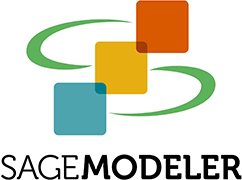SageModeler is a free, web-based systems dynamics modeling tool for middle and high school students to construct dynamic models. SageModeler is being developed at the Concord Consortium and the CREATE for STEM Institute at Michigan State University.
Modeling is key to how scientists approach understanding complex phenomena and how scientific and engineering problems are addressed. And like real scientists, students should explore systems and engage in system modeling as a necessary step in developing scientific literacy. A Framework for K-12 Science Education and the Next Generation Science Standards recognize the importance of systems and systems models as one of the key crosscutting concepts, and developing and using models as a key science and engineering practice.
SageModeler is an intuitive modeling tool for students to build their own models and validate their model design using real-world data. Research has shown that it engages students in the modeling practice and allows them to express their mental models in a way that can be discussed and tested.
Software features
- Graphical representation of variables and relationships, customizable by the student
- Simple drag-and-drop construction for creating a systems diagram
- Relationships between variables are defined without having to write equations
- Integrated with Common Online Data Analysis Platform (CODAP), an intuitive graphing and data analysis platform
Our Team
SageModeler is being developed by the Building Models and Multilevel Computational Modeling projects at the Concord Consortium and the CREATE for STEM Institute at Michigan State University (MSU).
Principal Investigators
Dan Damelin (PI, The Concord Consortium)
Joe Krajcik (PI, CREATE for STEM Institute, MSU)
Lynn Stephens (Co-PI, The Concord Consortium)
Project Staff
Tom Bielik, Jonathan Bowers, Emil Eiden, Tom Farmer, William Finzer, Li Ke, Cynthia McIntyre, Brianne Mohl, Consuelo Morales, Sebastian Opitz, Steven Roderick, Namsoo Shin, Israel Touitou
Software Developers
Sam Fentress, Chris Hart, Evangeline Ireland, Piotr Janik, Doug Martin, Noah Paessel, Jonathan Sandoe
Translators
Special thanks to the following for their translations.
Chinese (Simplified) — Peng He
Chinese (Traditional) — Silvia Wen-Yu Lee *
German — Marvin Rost
Greek — Ioannis Lefkos
Hebrew — Tom Bielik
Norwegian (Bokmal) — Guttorm Hveem
Norwegian (Nynorsk) — Thomas Bedin
Portuguese — Olayne Wellington
Spanish — Cristián Rizzi Iribarren
Thai — Pawat Chaipidech and Niwat Srisawaski
Turkish — Ibrahim Delen
* Thank you to Dr. Silvia Wen-Yu Lee’s research team at National Changhua University of Education for contributing the Chinese translation.
系統中文化由國立彰化師範大學李文瑜教授研究團隊翻譯完成。參與者:李文瑜、林栢川、曾一偵。
The Code
The SageModeler code is available at GitHub.
Licensing Information
This open-source software is licensed under the MIT license.
Suggested Citation
SageModeler [Computer software]. (2020). Concord, MA: The Concord Consortium and the CREATE for STEM Institute at Michigan State University.
This material is based upon work supported by the National Science Foundation under Grant Nos. DRL-1417809, DRL-1417900, DRL-1842035, and DRL-1842037. Any opinions, findings, and conclusions or recommendations expressed in this material are those of the author(s) and do not necessarily reflect the views of the National Science Foundation.
